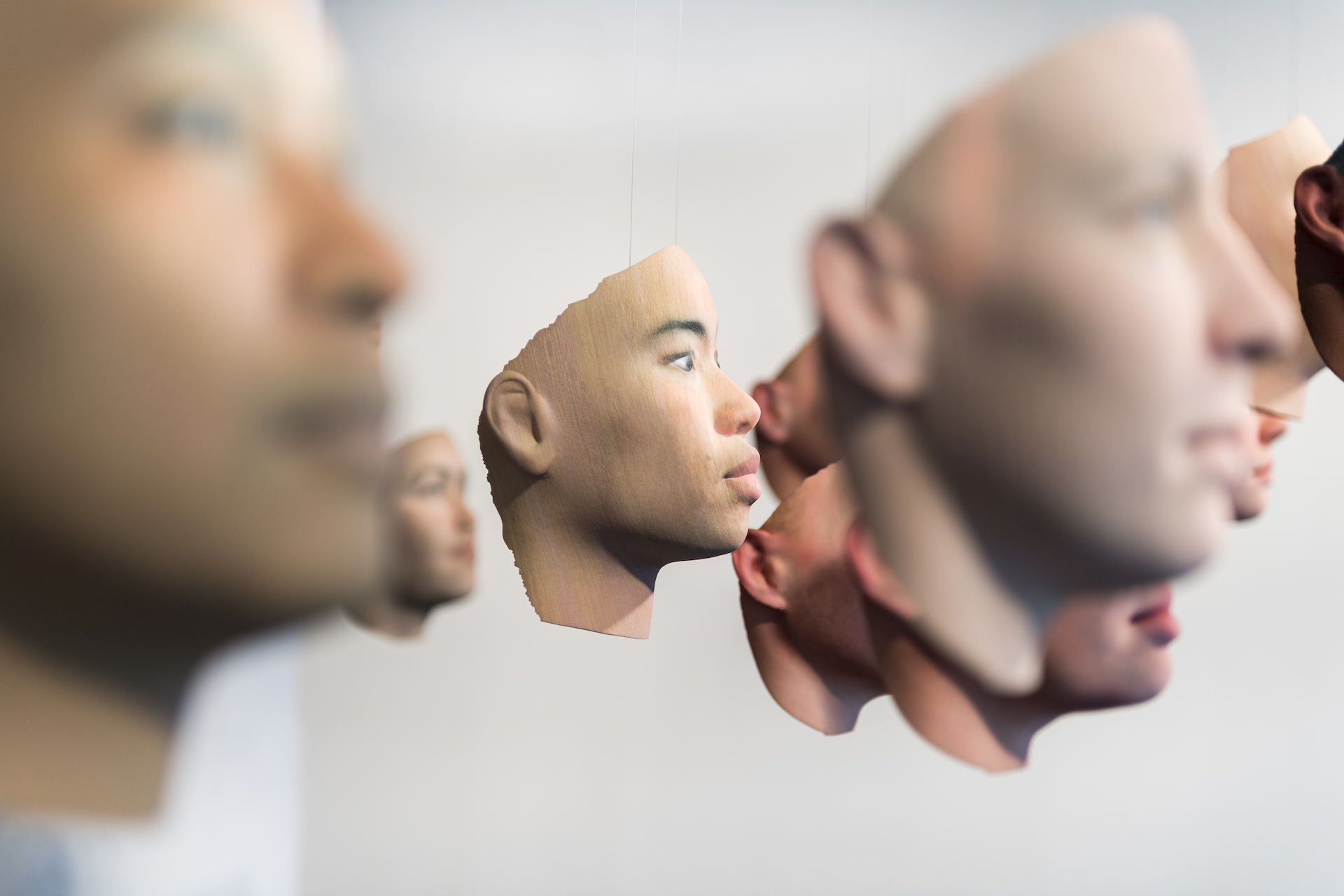
A clipped nail, an eyelash, a hair, a trace of lips at the edge of a glass, a chewing gum spat, a cigarette butt: we constantly scatter, without being fully aware of it, our DNA everywhere we go. Collecting these tiny bits and pieces of us, Heather Dewey-Hagborg reconstructs the plausible faces of the carriers of these macromolecules, which she identifies through biological analysis and cross-checks with the assumptions underlying contemporary forensics. It’s this series of portraits of strangers, Stranger Visions (2012-13), which has more widely brought to the public attention the practice of the artist and biohacker, and her critique of a genetic determinism that, although based on the latest technologies, is no less than the last in a long line of practices for classifying human beings into categories for the least contingent. While large-scale DNA collection in criminal investigations hit the headlines of the European press and the double helix of the DNA emoji has just been reoriented after igniting the scientific community, the New York artist gives us the ins and outs of her last two projects: Probably Chelsea (2017) and T3511 (2018).
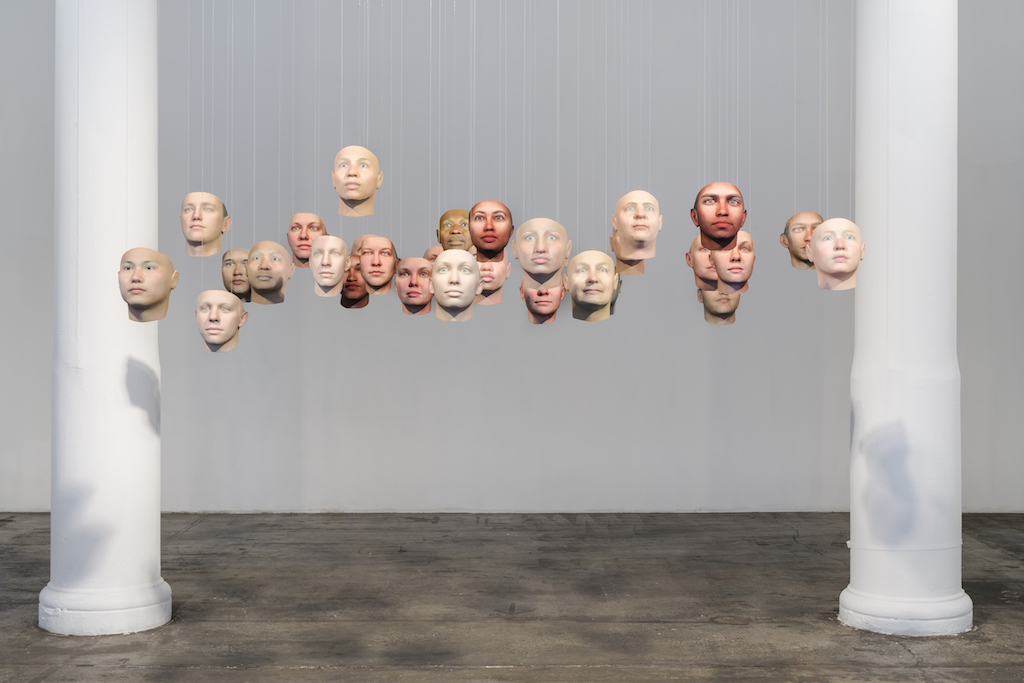
In 2015, a few months after starting the hormonal treatment that would lead her to the gender she recognizes as her own, Chelsea Manning, who was incarcerated for five years in maximum solitary confinement in a Texas military prison, is interviewed by mail for a magazine that also wants to publish a portrait of her. The problem is that she cannot be photographed, and we only know of her as a black-and-white selfie from around 2010 on which she is wearing a blonde wig. Apart from her relatives and lawyers, no one outside this prison really knows what she looks like now. It is through a few of her hair and some of her buccal cells that Heather Dewey-Hagborg first came into contact with her, producing through them two possible incarnations of that inaccessible face she unveiled in Radical Love: Chelsea Manning. Probably Chelsea now displays thirty versions of it, all equally plausible as to the information that the DNA of the Cablegate heroin carries. Thirty versions that Chelsea Manning was finally able to see for herself last summer in a gallery in Manhattan.
At the same time, Heather Dewey-Hagborg was obsessively imagining the face and life of a man whose saliva she owned. Here, she narrates the origins of this love story of post-genomic times, which the film T3511 will soon tell.
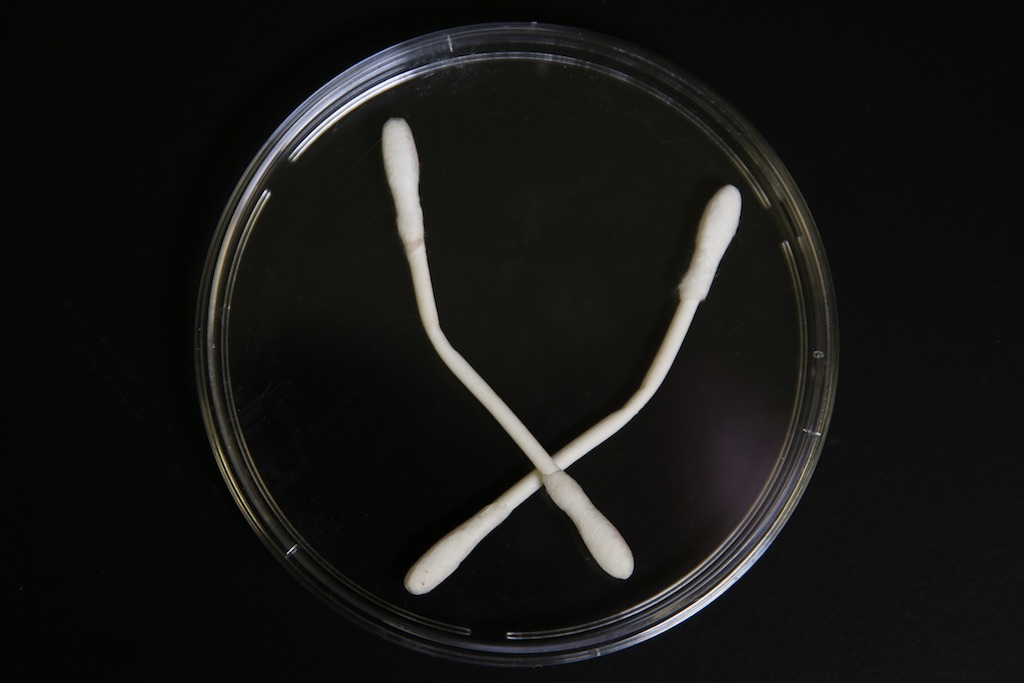
I remember when we first met, a year and a half ago, you had just bought a saliva sample and were wondering what you would end up doing with it. From where did you get it? I bought it from a supplier that sells to universities and clinics, for research. But it’s not very difficult to obtain; to acquire this type of thing in the US, you just need an academic or a business adress, and obviously, a business adress can be anything… I even had sometimes other things mailed directly to my apartment: human heart dna for instance. For my latest project, we did part of the shooting for the film in the biggest biobank in Denmark, which is in Copenhagen, and they have there blood samples from every baby that was born in Denmark since 1982, and hardly anyone knows it’s there. But things like this are linked to people, to national health records. The purpose of this bank is biological research, to provide researchers with dna, proteins, data, etc., so they can conduct large scale studies. In the US, every state collects its newborn bloodspots but they all do it independently, there is no federal requirement that it should be collected. And each state has a different list of tests, and uses different processes. There have been cases when people refused to allow their child to be entered in those biobanks, but it’s largely ignored, there is no consent form to be signed for that. It would be interesting to know if that also happens in other countries, and which data bases they connect these data to. Coming back to the saliva sample, I remember you were thinking of making a drink out of it… Oh, I had forgotten about that idea! I sent it to 23andMe, the personal genotyping service, and to another company of the like, and I also tried to harvest cells from it to grow them. My goal was to see if it would be easy to identify the donor and I found out that it was actually quite easy. It was coming from a genetic male so I mainly worked from the Y chromosome to extract data and crossed it with a database to guess that person’s last name. There are sorts of social networks built in these consumer services that people use to find their relatives, their ancestry. And when I put the data of this person on this website, I was contacted by an immediate relative, right after. So that’s an open service? It’s a commercial service. For 23andMe for example, you spit in a tube and send that to them, and they give you back a data profile for less than a hundred dollars.
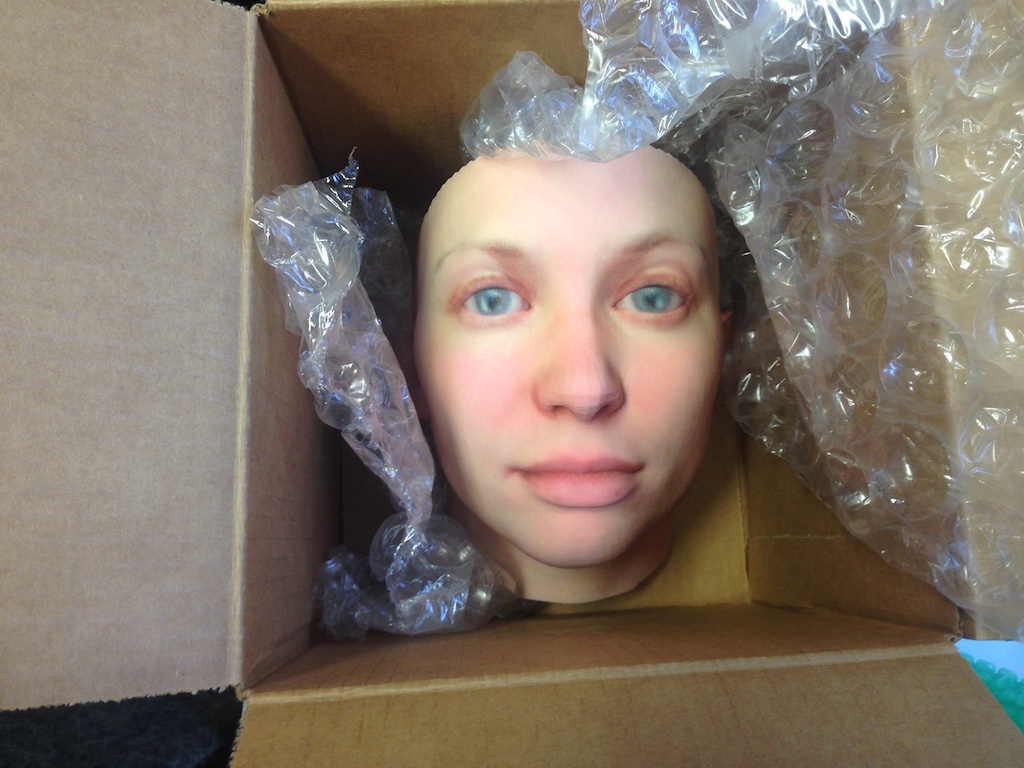
But nobody checks the accuracy of the information that circulates there? Nobody can check if it’s yours. So one could upload false data? Fake it with random numbers? Definitely. You could totally intervene in the data bases. It’s a good basis for a fiction then, uploading some made up DNA data and see if somebody corresponds to this… Absolutely. But, joking aside, does that work? If you want to connect with genetic relatives, that definitely works. Supposing that people have uploaded their data. Sure, but 23andMe already exceeded a million users a year ago. It’s basically the Facebook of DNA. I have now 2.700 genetic relatives. You share a lot of your dna with a lot of people! This opens the idea of family to change. Suddenly, your family is comprised of 3.000 people. There can be no secrets in a post-genomic era. What degree of precision are we talking about here? Well, 23andMe or one of these services might say: you have a 60% chance of having blue eyes. It’s not an inaccurate claim. You likely have ancestors from such and such region. There is a likelihood. It’s not that it’s false, it’s a reduction. And it could be wrong, because it is a prediction, a probability. And although the predisposition to genetic diseases some of these companies offer to disclose can lead to rather dramatic outcomes, it is the professional use of these techniques that is more urgently concerning, I assume that there must be data sharing with third parties, coming from the companies…Yes, it has become clear that DTC genome companies are just the next wave of Silicon Valley data harvesters, reselling genomes and likely physical materials as well to pharmaceutical companies and making additional information available to law enforcement upon request. As well as, as you explained in an essay published three years ago, forensic DNA phenotyping, which was a brand new technology at the time… While there are a few traits like eye and hair color that can be predicted from DNA with a high degree of certainty, the bulk of forensic DNA phenotyping relies on algorithmically derived statistical composites, so the use of this practice of rendering appearance from forensic samples as a crime investigation tool is extremely concerning! Parabon NanoLabs was the first company to produce DNA-derived portraits dedicated to the police which is their only customer! In order to do so, they make use of a dataset of 3D facial scans and DNA samples taken from research participants. The scans are processed to create a probabilistic representation of all possible faces drawn from, and limited by, this set of 3D scans. Then, the data is mined for correlations between DNA and facial shape by examining characteristics that are assumed to be opposite ends of a spectrum, like masculine and feminine or “European” and “African.” It’s really problematic. What does the idea of a female face mean? These technologies inevitably inscribe this idea of biological identity onto us, they still contain this idea of an essence which I think has to be broken. Even one of the scientists who was working on this technology has publicly turned against it: Mark Shriver was very involved in developing forensic phenotyping but he has said that Parabon has taken it too far. There’s such a market for forensics businesses that just make things up and sell them to the police: there are conferences full of companies that market their forensics products that work 51% of the time. So there is no regulation about it? Nothing. And there won’t be because it’s only for investigation, it’s not used in court. Only what is admitted in court is regulated, and even then it’s up to the decision of the judge. But when it comes to investigation, you can bring in a fortuneteller if you want. And it’s widely used? Enough for me to be worried. Can someone not related to the police access their service? No—of course, I tried!—which also means that no one can ever prove them wrong. And the difference between what they do and what you do, also in terms of accuracy, is not that big. It’s very similar. They look at a lot more of the genome, so there is more evidence, but not much more accuracy. Anyway, there is no criteria for what accuracy would be! How do you assess whether you accurately predicted someone’s face? The first step is to define criteria around these issues. Even if you take somebody’s dna predictions and then look at them and think that it looks pretty accurate, it’s totally subjective! Heather Dewey-Hagborg, Sample box for NYC, sample 4. Installation, Clocktower artist residency, 2013. That’s also why, for Stranger Visions, you generated different faces from the same DNA sample… Yes, for that, I studied at a community lab how to extract DNA and then I input the data in a software that I wrote to generate 3D representations of what the person from whom I had collected DNA might look like, based on genetic research. I generated a handful of possible faces for that person, around 5 to 10, and then chose the one that spoke to me the most, and 3D printed it. At the time, we were talking about cameras on the streets, wiretapping and all kinds of surveillance, but we were not talking about this in terms of the physical body. I discovered this technology that had not materialized yet, forensic phenotyping, in 2012-13, and then, in 2014, the first DNA snapshot portrait of a suspect was published. Look at their snapshot prediction results, these faces are incredibly generic! They are just basically the same face with differences in skin color, eye color, and hair color. And this very ambigous outcome of technology is delivered right in the hands of the police. Speaking of police, some police services contacted me after reading about my work in the media to ask for my collaboration. Why did they contact you if such companies existed? They didn’t exist yet, it was in 2012. Parabon NanoLabs launched at the very end of 2014. And people continue to contact me because they are very expensive. It’s fascinating to think of the police contacting an obvious artist… who is even critical of these processes on her website! Such collaborations never materialized, but I was contacted, in 2015, by Paper Magazine. They were conducting an interview with Chelsea Manning through the mail while she was in military prison (where it was impossible to photograph her). They asked me to produce a DNA-derived portrait of her in order to illustrate the interview, I immediately said yes. There was no photographs of Chelsea Manning available at all, she had her face literally censored. So I received an envelope with her hair clippings and cheek swab from which I extracted dna that I analyzed to generate portraits of her.
Heather Dewey-Hagborg, Sample box for NYC, sample 4. Installation, Clocktower artist residency, 2013. That’s also why, for Stranger Visions, you generated different faces from the same DNA sample… Yes, for that, I studied at a community lab how to extract DNA and then I input the data in a software that I wrote to generate 3D representations of what the person from whom I had collected DNA might look like, based on genetic research. I generated a handful of possible faces for that person, around 5 to 10, and then chose the one that spoke to me the most, and 3D printed it. At the time, we were talking about cameras on the streets, wiretapping and all kinds of surveillance, but we were not talking about this in terms of the physical body. I discovered this technology that had not materialized yet, forensic phenotyping, in 2012-13, and then, in 2014, the first DNA snapshot portrait of a suspect was published. Look at their snapshot prediction results, these faces are incredibly generic! They are just basically the same face with differences in skin color, eye color, and hair color. And this very ambigous outcome of technology is delivered right in the hands of the police. Speaking of police, some police services contacted me after reading about my work in the media to ask for my collaboration. Why did they contact you if such companies existed? They didn’t exist yet, it was in 2012. Parabon NanoLabs launched at the very end of 2014. And people continue to contact me because they are very expensive. It’s fascinating to think of the police contacting an obvious artist… who is even critical of these processes on her website! Such collaborations never materialized, but I was contacted, in 2015, by Paper Magazine. They were conducting an interview with Chelsea Manning through the mail while she was in military prison (where it was impossible to photograph her). They asked me to produce a DNA-derived portrait of her in order to illustrate the interview, I immediately said yes. There was no photographs of Chelsea Manning available at all, she had her face literally censored. So I received an envelope with her hair clippings and cheek swab from which I extracted dna that I analyzed to generate portraits of her.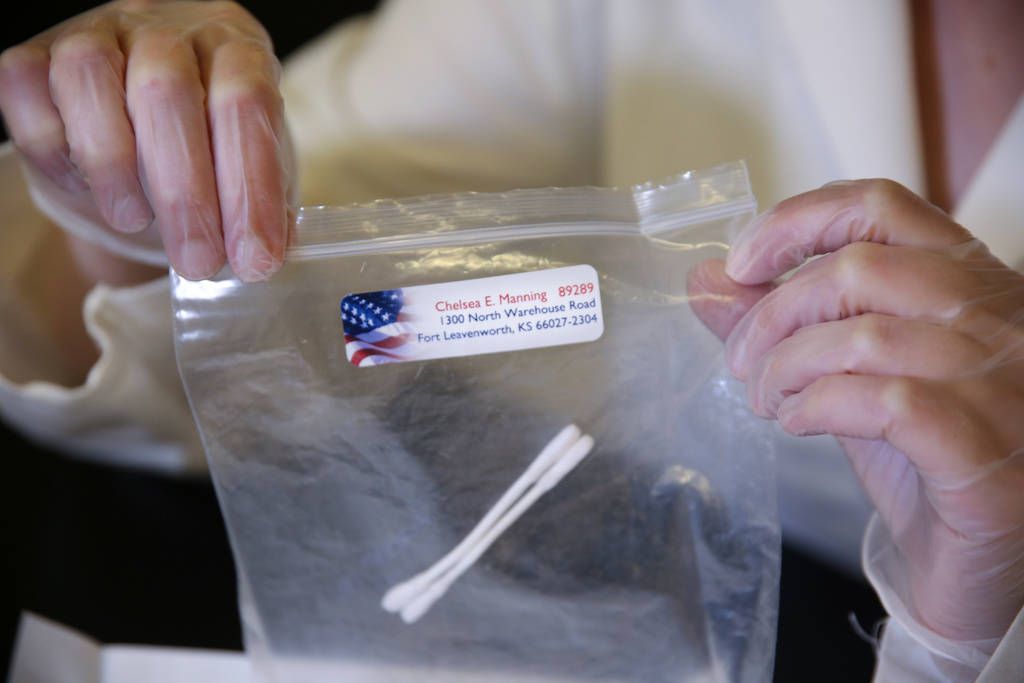 Documentation, Radical Love, 2016. Courtesy Heather Dewey-Hagborg. Photo : Thomas Dexter And you first came up with two versions, one with an algorithmically neutral gender, and the other, assigned female… I generated two versions of her portrait, one androgynous, with the gender parameter left at zero, and the other parameterized female, how she self-identifies. I exhibited these two faces side by side, to show specifically how limiting the idea of biological sex really was and how absurd it is to have some kind of stereotyped idea of what a gendered face is supposed to look like. Two years later, once Chelsea was finally released after seven years of incarceration, you exhibited together a series of thirty different faces issued from her DNA, Probably Chelsea, where a multiplicity of shapes of eyes, of noses, of lips, develop in a great variety of skin colors, the better to give the feeling of a united group, facing us. What gives such latitude to those variations? Genomic data can tell a multitude of different stories about who and what you are. Probably Chelsea shows just how many ways your DNA can be interpreted as data, and how subjective the act of reading DNA really is. There are 6 billion base pairs in the human genome, most of which are shared among all of us. Most variations between people are in non-coding regions, i.e. the spaces in between our genes that have no known function. Meanwhile, it is becoming increasingly clear that the influence of the environment alters gene expression, turning genes on and off in various levels and combinations. So what can a genome tell us? It can give us clues, or probabilities of phenotypes. It can relate people to their families and recent ancestors. And it can connect to an archaeology of deep human and evolutionary history. But not with certainty; always only as probabilities. DNA can tell many stories, and as with all data, it lends itself to multiple interpretations. For example, the GG variant of Chelsea’s rs12913832 polymorphism, which is often considered synonymous with blue eyes in Northern Europeans, is also found in Hispanic, African American, and South Asian populations, with varying phenotypes. So the same exact data can be read in different ways. This variant might predict she is most likely to have blue eyes and be of European ancestry, but there is still a good chance she could have brown eyes and she might not have much or any European ancestry at all. Each genomic variation is a piece of data, a new clue and another possible story. As more data is put together some things become more probable, and some less, but there is never certainty and there are always alternate possible narratives. Probably Chelsea portrays these alternate narratives and represents a sampling of the many stories Chelsea’s DNA can tell.
Documentation, Radical Love, 2016. Courtesy Heather Dewey-Hagborg. Photo : Thomas Dexter And you first came up with two versions, one with an algorithmically neutral gender, and the other, assigned female… I generated two versions of her portrait, one androgynous, with the gender parameter left at zero, and the other parameterized female, how she self-identifies. I exhibited these two faces side by side, to show specifically how limiting the idea of biological sex really was and how absurd it is to have some kind of stereotyped idea of what a gendered face is supposed to look like. Two years later, once Chelsea was finally released after seven years of incarceration, you exhibited together a series of thirty different faces issued from her DNA, Probably Chelsea, where a multiplicity of shapes of eyes, of noses, of lips, develop in a great variety of skin colors, the better to give the feeling of a united group, facing us. What gives such latitude to those variations? Genomic data can tell a multitude of different stories about who and what you are. Probably Chelsea shows just how many ways your DNA can be interpreted as data, and how subjective the act of reading DNA really is. There are 6 billion base pairs in the human genome, most of which are shared among all of us. Most variations between people are in non-coding regions, i.e. the spaces in between our genes that have no known function. Meanwhile, it is becoming increasingly clear that the influence of the environment alters gene expression, turning genes on and off in various levels and combinations. So what can a genome tell us? It can give us clues, or probabilities of phenotypes. It can relate people to their families and recent ancestors. And it can connect to an archaeology of deep human and evolutionary history. But not with certainty; always only as probabilities. DNA can tell many stories, and as with all data, it lends itself to multiple interpretations. For example, the GG variant of Chelsea’s rs12913832 polymorphism, which is often considered synonymous with blue eyes in Northern Europeans, is also found in Hispanic, African American, and South Asian populations, with varying phenotypes. So the same exact data can be read in different ways. This variant might predict she is most likely to have blue eyes and be of European ancestry, but there is still a good chance she could have brown eyes and she might not have much or any European ancestry at all. Each genomic variation is a piece of data, a new clue and another possible story. As more data is put together some things become more probable, and some less, but there is never certainty and there are always alternate possible narratives. Probably Chelsea portrays these alternate narratives and represents a sampling of the many stories Chelsea’s DNA can tell.
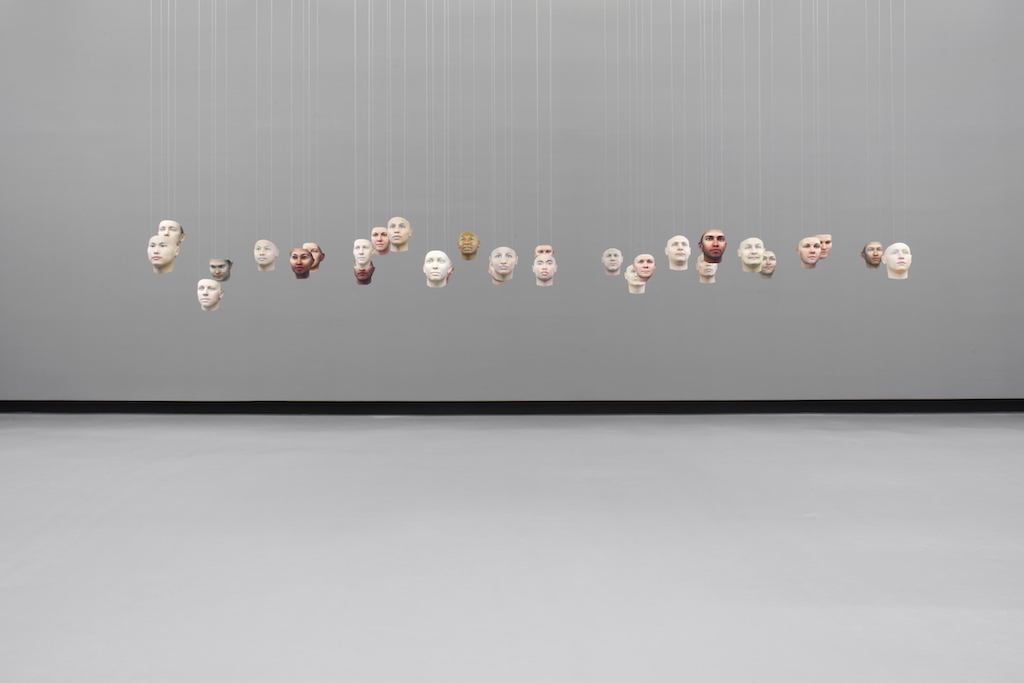 Heather Dewey-Hagborg & Chelsea E. Manning, A Becoming Resemblance, 2017. Installation view, Transmediale 2018, HKW, Berlin. Photo : Luca Girardini.
Heather Dewey-Hagborg & Chelsea E. Manning, A Becoming Resemblance, 2017. Installation view, Transmediale 2018, HKW, Berlin. Photo : Luca Girardini.
Originally published in 02#85, Spring 2018, on the occasion of the following exhibitions/events:
Big Bang Data, MIT, Cambridge, 11.10.2017 – 30.03.2018
A Becoming Resemblance (solo), Transmediale, HKW, Berlin, 31.01 – 04.02.2018
I am here to learn, Frankfurter Kunstverein, 15.02 – 08.04.2018
Stranger Visions (solo), Emory & Henry College, Virginia, 12.02 – 09.03.2018
IFVA Festival, Hong Kong Arts Centre, 06.03 – 20.03
Genomic Intimacy, MU, Eindhoven, 11.05 – 08.07.2018
The Future Starts Here, Victoria and Albert Museum, London, 12.05 – 04.11.2018